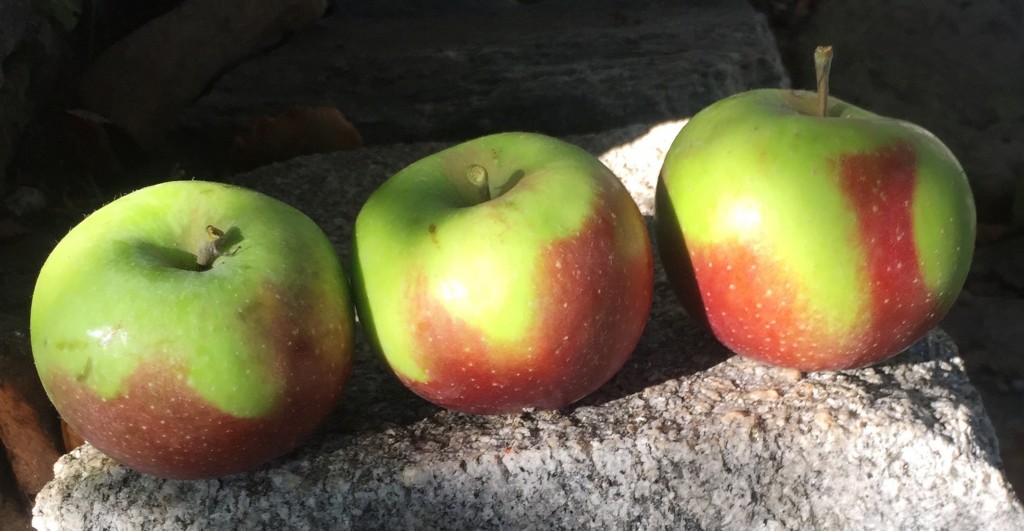Newtown Pipin – The Real Big Apple?

We purchased a house off Shinnecock Bay on Long Island half a lifetime ago. The house was recommended to us by a friend in the dead of winter. You could barely see the formal flower beds but the fruit trees and the Long Island cedars soared over the cover of burlap and snow. The house itself was not even open for us to see. It was small and clearly an accessory to the garden. We were told it was “quite the find”….and yes, I have to say it was.
On an early Spring day we drove up to our new home and a thousand tulips were in bloom. When I first saw this garden, I immediately took ownership of this “Little Eden”. Anchoring the abandoned orchard was an overgrown apple tree – pushing out sweet scented blossoms. It was enormous. We soon made friends with gardeners and arborists who suggested the tree “be taken back”. It was, after all, twice the size of our living room. And over the years Janier pruned back the tree and we started to harvest fruit. Eight bushels the first year and twelve the next – small red and green apples, tart as hell. But we noticed how they got sweeter as we allowed them to rest between picking time on Columbus Day and making pies with them on Thanksgiving.




As the years passed my brother hung a swing in the arbor of the tree for our daughter. We picked apples every fall and I bought Sean a cider mill. We were getting 18 to 24 bushes of apples from our tree and did our very best to use them. Making jars of apple sauce, apple butter and cider. When we were exhausted we gave them to a horse farm. They were a gift for one and all.
This year was out landfall – 42 bushes of apples from this one centennial tree. I have been told by some of our neighbors that our garden was part of an orchard. Just off Shinnecock Bay an incredible microclimate for apricots and apples. The apricots were long gone and this grand old tree was worth a bit of research.
It turns out that this is an American Heirloom Apple – the Newtown Pipin originated in the late 17th or early 18th century and still cultivated on a small scale In New York, Virginia and the Pacific Northwest.
According to my research, the Newtown Pippin is “typically light green, sometimes with a yellow tinge. It is often russeted around the stem. The flesh is yellow and crisp. The flavor is complex and somewhat tart, and requires storage to develop properly; some sources ascribe to it a piney aroma.”
This variety originated as a chance seedling (a “pippin”) on the Gershom Moore estate in the village of Newtown now called Elmhurst. The Moore property stood in the vicinity of what is now Broadway and 45th Avenue in Queens County on Long Island, New York in the late 17th or early 18th century.
The Newtown Pipin was widely grown in colonial America and used for deserts and cider making. Thomas Jefferson praises the Pipin when he wrote from Paris that “they have no apples here to compare with our Newtown Pippin.”
Both George Washington and Thomas Jefferson grew the Newtown in Virginia, where it acquired the alternate name “Albemarle Pippin” after Albemarle County, Virginia. It became the preferred Apple when in 1838 Andrew Stevenson, the American minister to Great Britain, presented Queen Victoria with a gift basket of the apples from his wife’s Albemarle County orchard. Victoria liked them so much she requested the British Parliament lift import duties on the variety, and it was an important export until World War II.

Interestingly, Sean grew up not far from Newtown and my mother now lives close by in Queens. I work out of a kitchen in Astoria making the Newtown Pipin Tree part of our heritage as well. The New York City Department of Parks and Recreation, New York Restoration Project and Slow Food NYC is providing hundreds of Newtown Pippin saplings to community gardens, schools, parks and other public spaces throughout NYC city. Maybe the Newtown Pipin really is The Big Apple – but that will remain research for another day.


